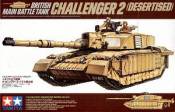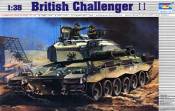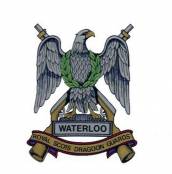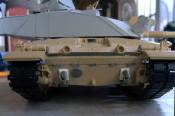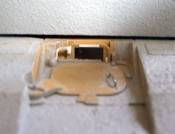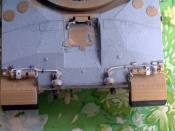1⁄35An Accurate Challenger II
1
Comment

introduction
The Challenger 2 (C2) is the newest tank of the British Armoured Corps. It is a further development of the Challenger 1 (C1) which served in Operation Desert Sabre and in peacekeeping operations in the Balkans. The C2 incorporates many improvements over the C1, in particular the latest laminated armour technology, a new L30 rifled 120mm main gun, tank optics, improved fire control system, a new diesel power plant, and improved suspension. The first unit to receive the C2 was the Royal Scots Dragoon Guards, 7th Armoured Brigade, 1st UK Armoured Division. The Scots DG can claim to be the oldest surviving Cavalry of the Line in the British Army, tracing its history from two famous regiments – the 3rd Carabiniers and the Royal Scots Greys – serving with distinction from Blenheim in 1702 and Waterloo in 1815, to Operation Desert Sabre in 1991 and Operation Telic in 2003. With the C2, the RSDG continues the tradition of one of the finest cavalry units in the world. “One-One-Bravo” (11B) is the call sign of the tank of the Commanding Officer of the Scots DG. Its Zap code is 400 and serial number 62KK82. It is distinguished from other tanks in the regiment by having the Lion Rampart emblazoned on both sides of the turret. The kit used is Tamiya’s Challenger 2 (Desertised) as seen in Op Telic. The kit is limited only to an up-armoured, desertised version of the C2. However, this has become a common sight in various internet discussion boards, pictures, news (courtesy of CNN, BBC, Time, Newsweek, et. al.), exhibits and contests. So, as a (refreshing, perhaps?) change to the usual, desert coloured, desertised C2, I decided to convert and accurise it into a basic C2 in typical British Army 2-colour camouflage scheme, specifically 11B of the Scots DG.building the hull
Tamiya’s C2 kit is limited to a desertised, up-armoured version of the C2. As such, some components that would appear in a plain C2 are not included in the kit. The kit, like the “infamous” “new” M1A2 of Tamiya, also has no anti-slip coating on the hull and turret surfaces. Nonetheless, the kit itself is quite accurate and has the typical “shake-and-bake” fit quality that one expects from Tamiya. First order of business was to find or scratchbuild the parts needed to convert the kit to a plain C2. Many of the parts that were needed came from another C2 kit, that of Trumpeter’s first-release C2. At this point, one could ask “Why bother ‘downgrading’ Tamiya’s C2 when this guy can simply improve Trumpeter’s first-release C2 kit?” Firstly, Tamiya’s C2 is a better fit and has better details compared to Trumpeter’s first C2 kit. This in turn would make conversion and accurizing simpler, since the base kit already has excellent fit and a lot of its details are accurate, thereby reducing the amount of scratchbuilding or accurizing needed to improve Trump’s first C2 kit. The parts taken from the Trump kit are C31, C39, C50, C54, C58, C59, E9, and D32. These were all added to the Tamiya kit because these were missing (particularly the hull front, because with the add-on armour, they were left out completely by Tamiya since, after all, they would be hidden, and thus were not needed). A comparison with pictures of C2’s particularly the real 11B shows that the hull had handles at the sides and at the front, which were either entirely lacking or molded on with the hull. These were rectified by using aluminum strips cut from aluminum fasteners.Comments
Lovely Challenger, not quite so lovely maths....
Scale weight of a 1/35th Challenger (real weight 62500kg) is more like 1.45kg.
JAN 09, 2006 - 08:15 PM
Copyright ©2021 by Agustin Tirona. Images and/or videos also by copyright holder unless otherwise noted. The views and opinions expressed herein are solely the views and opinions of the authors and/or contributors to this Web site and do not necessarily represent the views and/or opinions of Armorama, KitMaker Network, or Silver Star Enterrpises. All rights reserved. Originally published on: 2006-01-10 00:00:00. Unique Reads: 25986




